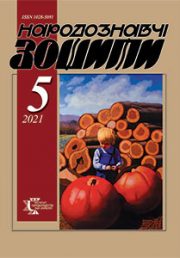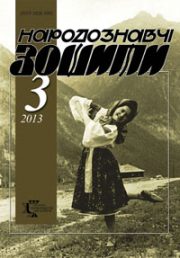The Ethnology Notebooks. 2018, 6 (144), 1448–1455
UDK 398.88(=161.2=162.1):398.392.4](082)»1790»
DOI https://doi.org/10.15407/nz2018.06.1448
Received 21.11.2018
CAROLS FROM THE «BOHOHLASNYK» (1790): THE FUNCTIONING IN UKRAINIAN AND POLISH ETHNOCULTURES
ORCID ID: https://orcid.org/0000-0002-9379-8300
Kharchyshyn Olga Mykhailivna, Candidate of Philology,
Senior Researcher, Department of Folklore Studies
at the Institute of Ethnology of National Academy of Sciences of Ukraine.
15 Svobody Avenue, 79000, Lviv, Ukraine.
Contacts: Tel.: (032) 297-01-57; e-mail: okharchyshyn@gmail.com
Abstract. Ukrainians and Poles have well-preserved traditions of carol singing — a collective choral performance of spiritual songs carols «koliada», dedicated to the Nativity of Christ. Christmas Carols also include the songs of book-based church origin. They are played and sung during the holiday period in temples, people’s homes, in many public places in live performances or in audio recordings of various musical resources. These songs create a festive atmosphere, uniting participants of celebrations. Carols of Ukrainians and Poles in a number of manifestations are characterized by a common origin, expressive features of neighbouring ethnic cultures. This article analyzes the state of preservation and modern life in the Ukrainian and Polish ethnic cultures of the Christmas carols «Nebo i Zemlia» («Heaven and Earth») («Dzisiay v Betleyem» («Today in Bethlehem»))), «V Yaslakh Lezhyt» («Lying in the manger») («V Zhlobie Lezhy» («Lying in the manger»), «Anhel Pastyriam Movyv» («The Angel Told Shepherds») («Aniow Pastezhom Muviw» («The Angel Told Shepherds»)) and others, first published in the collection of spiritual songs «Bohohlasnyk», published in the Pochayiv Monastery in 1790. Some carols of «Bohohlasnyk» had been spread before (known from the manuscript collections of the seventeenth and eighteenth centuries), while others were original samples created by monks. Latin translations and borrowings from other Western languages took a remarkable place in the carol repertoire. It has been discovered that these and some other Christmas songs are a common property of Ukrainians and Poles, living simultaneously in two language versions. The tradition of enriching neighbouring ethnic cultures with new Christmas carols has been developing for centuries up to this day. Carols (in particular, their lyrics) undergo modifications due to the requirement of time.
Keywords: Christmas songs, carols, «Bogoglasnyk», Ukrainians, Poles, tradition, ethnoculture, life, mutual enrichment.
REFERENCES
Bohohlasnyk: pisny blahohoviinyia prazdnykom hospodskym, bohorodychnym y narochytykh sviatykh. (1790). Pochaiv: Drukarnia Uspenskoho monastyria [in Ukrainian].
Bohohlasnyk. (1850). Lviv [in Ukrainian].
Bohohlasnyk. (1825). Pochaiv: Drukarnia Uspenskoho monastyria [in Ukrainian].
Hnatiuk, V. (1914). Peredne slovo. In Koliadky i shchedrivky. Zibrav V. Hnatiuk. In Etnohrafichnyi zbirnyk (Vol. 35, pp. I—XIV). (Ch. 1). Lviv [in Ukrainian].
Hnatiuk, V. (1902). Uhroruski dukhovni virshi. In Zapysky NTSh (Vol. 46, pp. 1—68). Lviv [in Ukrainian].
Hnatiuk, O. (1994). Ukrainska dukhovna barokova pisnia. Varshava; Kyiv: Pereval [in Ukrainian].
Koliady i shchedrivky z dodatkom tropariv. (1900). Lviv [in Ukrainian].
Koliady, abo Pisni z notamy na Rizdvo Khrystove. (1925). Zhovkva [in Ukrainian].
Hlushko, M., & Kyrchiv, R. (Uporiad., vstup. st., prym.). (1991). Koliadky i shchedrivky. Kyiv: Muzychna Ukraina [in Ukrainian].
Koliadky. (2000). Zhovkva: Misioner, vydavnytstvo Ottsiv Vasyliian [in Ukrainian].
Kovpak, Vasyl (Ed.). (2004). Koliadnyk (kantychka). Vydannia druhe, dopovnene. Lviv: Triada Plius [in Ukrainian].
Kostiukovets, L. (1993). Iz sposterezhen nad istoriieiu rozvytku rizdvianykh psalmiv-koliadok. In Zapysky NTSh (Vol. 26, pp. 228—243). Lviv [in Ukrainian].
Kudryk, B., & Yasinovskyi, Yu. (ed.). (1995). Ohliad istorii ukrainskoi tserkovnoi muzyky. Lviv [in Ukrainian].
Medvedyk, Yu. (2015). Ad Fontes: z istorii ukrainskoi muzyky XVII — pochatku XX st. vybrani statti, materialy, retsenzii. Lviv: LNU im. Ivana Franka [in Ukrainian].
Medvedyk, Yu. (2016). Rukopysni zbirnyky z zapysamy pisen «Bohohlasnyka». In Medvedyk, J. Bogoglasnik — Pмsni blagogovмjnyja (1790/1791): Eine Sammlung geistlicher Lieder aus der Ukraine [in Ukrainian].
Medvedyk, Yu. (2006). Ukrainska dukhovna pisnia XVII—XVIII st. Kyiv [in Ukrainian].
Melnyk, Ya. (2011). «Choho shche ne zghryz zub chasu»: ukrainski rukopysni zbirky v naukovii spadshchyni Mykhaila Vozniaka. Ukrainske literaturoznavstvo, 73, 220—227 [in Ukrainian].
Misko, H. (2013). Rizdviani koliady na Ternopilshchyni. Heneza i suchasnist. Mystetstvoznavstvo Ukrainy, 3, 110—115 [in Ukrainian].
Smoliak, O. (2011). Apokryfichni koliadky z maloi batkivshchyny Volodymyra Hnatiuka (selo Velesniv Monastyrskoho raionu Ternopilskoi oblasti). In Naukovi zapysky Ternopilskoho natsionalnoho pedahohichnoho universytetu im. V. Hnatiuka. Ser. Literaturoznavstvo, 32, 6—70: Volodymyr Hnatiuk u konteksti rozvytku kultury Ukrainy: materialy Mizhnarodnoi nauk. konferentsii: do 140-richchia vid dnia narodzhennia V. Hnatiuka [in Ukrainian].
Franko, I. (1983). Dukhovna y tserkovna poeziia na Skhodi y na Zakhodi. Vstup do studii nad «Bohohlasnykom». In Franko, І. Zibrannia. tvoriv: u 50-ty tt. (Vol. 39, pp. 126—143). Kyiv: Nauk. dumka [in Ukrainian].
Franko, I. (1980). Nashi koliady. In Franko, I. Zibrannia tvoriv: u 50-ty t. (Vol. 28, pp. 7—42). Kyiv [in Ukrainian].
Kantyczka czyli kolкdy i pastoraіki. (1892). Lwуw, 1892 [in Polish].
Nowak-Dіuїewskij, J. (ed.). (1966). Kolкdy polskie. Њredniowiecze i wiek XVI (Vol. I—II). Warszawa [in Polish].
Kolкdy w ukіadzie cztergoіosowym na chor miкszany i mкski. (1898). Lwуw [in Polish].
Medvedyk, J. (2016). Bogoglasnik — Pмsni blagogovмjnyja (1790/1791): Eine Sammlung geistlicher Lieder aus der Ukraine. Herausgegeben von Hans Rothe in Zuzammenarbeite mit Jurij Medwedyk. Kцln; Weimar; Wien: Bцhlau, 2016 [in Ukrainian].
Siedlecki, J., & Kaіamarz, W. (ed.). (2017). Њpiewnik noњcielny (Wyd. XLI). Krakуw [in Polish].
«Anhel pasteriam movyv». Retrieved from: https://www.youtube.com/watch?v=Euqf_pkUw-Y [in Polish].
Koliady i shchedrivky na Rizdvo Khrystove i Bohoiavlenie (1918). Vinnipeh: Ruska knyharnia Retrieved from: https://nashe.com.ua [in Ukrainian].
Litopys not. Derzhavnyi bibliohrafichnyi pokazhchyk Ukrainy. (2007). P. 7. Retrieved from: http://www.ukrbook.net/litopys/Notu/2006/LN_06.pdf [in Ukrainian].
Slukhaiemo i spivaiemo koliady (2017). Retrieved from: http://www.nasze-slowo.pl/spivaiemo-i-sluhaiemo-koljadi/ [in Ukrainian].
Kharchyshyn, O. (2017). Koliady — spilna spadshchyna ukraintsiv i poliakiv. Retrieved from: https://culture.pl/ru/article/kolyadi-spilna-spadshchina-ukrayinciv-ta-polyakiv [in Ukrainian].
Khor — «Nebo i Zemlia» (2016). Rizdvianyi kontsert na Yevropeiskii ploshchi. Retrieved from: https://www.youtube.com/watch?v=vBl4lw6xOuw [in Ukrainian].
Charzhyshyn, O. (2017). Kolкdy — wspуlna tradycja polsko-ukraiсska. Retrieved from: https://culture.pl/pl/artykul/koledy-wspolna-tradycja-polsko-ukrainska [in Polish].
Wszyscy Artyњci — «Dzisiaj w Betlejem» (2017). Retrieved from: https://www.youtube.com/watch?v=C86VIJSAzx0 [in Polish].
«Kolкdy pod wspуlnyn niebem» (CD): Wykonawca Enej (2018). Retrieved from: https://www.empik.com/koledy-pod-wspolnym-niebem-enej,p1219010570,muzyka-p [in Polish].







